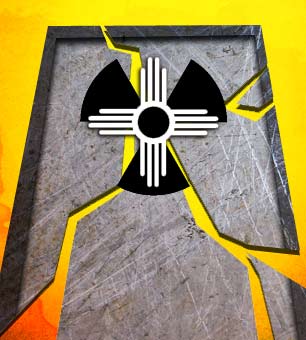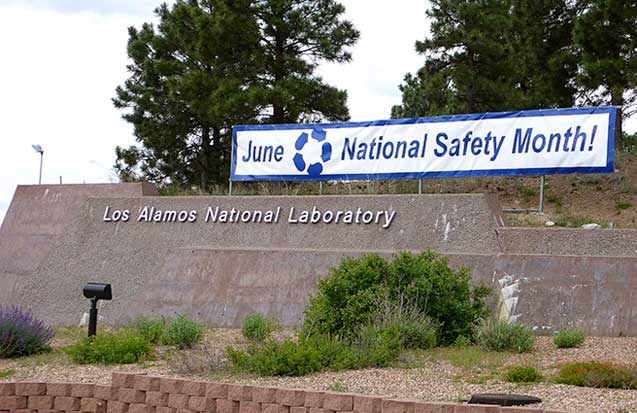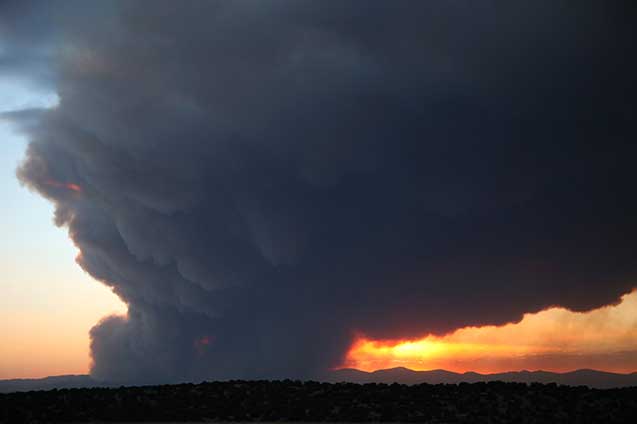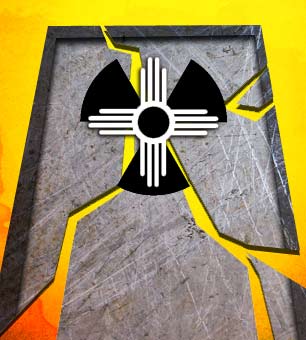Part of the Series
Planet or Profit
 (Image: Jared Rodriguez / Truthout)A recent fire and radiation release at New Mexico’s Waste Isolation Pilot Plant (WIPP) uranium repository has brought renewed focus on the problem of what to do with a growing stockpile of radioactive waste and spent fuel from commercial nuclear reactors.
(Image: Jared Rodriguez / Truthout)A recent fire and radiation release at New Mexico’s Waste Isolation Pilot Plant (WIPP) uranium repository has brought renewed focus on the problem of what to do with a growing stockpile of radioactive waste and spent fuel from commercial nuclear reactors.
The radiation release February 14, 2014, exposed at least 13 workers, after an alarm sounded and high levels of radiation were released from the underground repository in southeastern New Mexico, where nuclear waste from federal nuclear labs and weapons sites, along with discarded machinery, clothing and other radioactive waste is stored.
A second alarm sounded shortly after the first, indicating radiation at even higher levels.
Less than two weeks earlier, on February 5, a truck delivering radioactive waste had caught fire inside the facility, although operators of the facility claim the two incidents were not related.
Experts have told Truthout that radiation leaks from the facility are “a troubling sign” and expressed concern about the future of storing radioactive material at the site, which is near Carlsbad, New Mexico. WIPP receives 17 to 19 shipments every week from sites around the country, including Los Alamos, New Mexico, and installations in Idaho, Illinois and South Carolina.
 Los Alamos National Laboratory, site of the Manhattan Project and where the first nuclear bombs were developed, continues to carry out classified work in designing nuclear weapons. (Photo: Erika Blumenfeld)
Los Alamos National Laboratory, site of the Manhattan Project and where the first nuclear bombs were developed, continues to carry out classified work in designing nuclear weapons. (Photo: Erika Blumenfeld)
Numerous operational gas and oil wells within one mile of the site, in addition to the fact that fracking is now ongoing nearby, have other experts like Don Hancock, the director of the Nuclear Waste Safety Program at Southwest Research and Information Center, alarmed.
“The 16-square-mile WIPP site is surrounded by more than 100 operating oil and natural gas wells within a mile of the boundary,” Hancock told Truthout.
“Fracking also is being done around the site, so there is some likelihood of fracking fluids penetrating areas at or near waste emplacement,” he added.
Hydrofracturing, or “fracking,” is a technique used in obtaining gas and petroleum in which water is mixed with sand and toxic chemicals, and the mixture is injected at extremely high pressure into a wellbore to create small fractures, along which gas and petroleum migrate to the well.
Fracking also causes earthquakes, hence the concern of using the technique where tons of radioactive material are being stored, along with the fact that fracking could damage the container around the waste.
“Given that some of the wastes at WIPP are dangerous for thousands of generations, it is not an ideal place for storing wastes, Hancock added.
Fracking, Fires and Other Problems
Hancock, who has been monitoring WIPP since 1975 and is familiar with the technical, policy, regulatory and legal issues related to the site, believes that pressure to expand WIPP could have led to the recent fire at the site.
“In recent years, WIPP officials have put time, effort and money into proposals and actions to expand WIPP to additional, more radioactive wastes, rather than maintaining a strong safety culture,” Hancock said. “In my view, those actions contributed to the underground fire on February 5 and the radiation leaks.”
Steve Frishman, a geologist who has served as a technical and policy consultant to the Nevada Agency for Nuclear Projects and the attorneys representing the state in the Yucca Mountain licensing proceeding since 1987, expressed a similar opinion.
“It concerns me that WIPP was sited in a known hydrocarbon field when a principle of siting deep geologic radioactive waste disposal facilities is avoidance of areas with known and accessible natural resources,” Frishman told Truthout. “Such avoidance enhances confidence that waste isolation over the long period necessary will not be disrupted by human intrusion. A more deliberative site selection and evaluation process could have resulted in siting that avoids this risk.”
WIPP is the world’s third deep geological repository constructed and licensed to permanently dispose of radioactive waste for 10,000 years. The repository sits approximately 26 miles east of Carlsbad, in an area known as the southeastern New Mexico nuclear corridor.
The moniker is due to the fact that this area also includes the National Enrichment Facility near Eunice, New Mexico, the Waste Control Specialists low-level waste disposal facility just over the border near Andrews, Texas, and the International Isotopes facility to be built near Eunice, New Mexico.
Since shipments began in 1999, more than 80,000 cubic meters and 11,000 shipments of waste have been transferred to WIPP.
The New Mexico repository places the waste inside shafts within an ancient salt bed more than 2,000 feet below the surface, which is supposed to collapse eventually around the waste and, in theory, seal it.
Many New Mexicans fought the project, knowing that in the expected 10,000-year life of the project there eventually would be problems. A poll found residents of southern New Mexico oppose the project three to one, but because of considerable encouragement from local businessmen and politicians, the project eventually moved forward. Locals felt their concerns had been ignored, while local and state politicians used the depressed economic conditions in southern New Mexico to push the project forward since it promised jobs. Given that it is a mere 15 years since the site began receiving waste, the concern appears to be justified.
In addition to the leak, the February 5 truck fire in one of the tunnels triggered a shutdown of the facility.
WIPP officials at the site discounted any effect of the current leak on human health, saying no radiation escaped to the surface. But they did not speak about the extent of the problem or how it eventually would be cleaned up.
“Officials at WIPP continue to monitor the situation,” spokeswoman Deb Gill said. “We are emphasizing there is no threat to human health and the environment.”
Contradicting Gill’s assurances that the radiation leaks from WIPP did not pose a threat to humans or the environment, plutonium readings were detected at a U.S. Department of Energy field office half a mile from the site. Joe Franco, the manager of the DOE field office, confirmed the readings.
If breathed or swallowed, plutonium generally stays in the body for decades and continues to expose the surrounding tissues to radiation. This may eventually increase the chance of developing cancer, but with low doses it would likely be several years before such cancer effects became apparent.
The WIPP site remains shut down as the DOE and other groups investigate the cause of the release. There is no date set for when the site will reopen, which means areas like Los Alamos will continue to have to store radioactive waste on site.
Wildfires in 2011 burned precariously close to the radioactive waste site at Los Alamos, where it is stored above ground in barrels.
 Several times wildfires have come close to the nuclear waste at Los Alamos, nearly causing what would be a national disaster. (Photo: Erika Blumenfeld)
Several times wildfires have come close to the nuclear waste at Los Alamos, nearly causing what would be a national disaster. (Photo: Erika Blumenfeld)
Since that time, most of New Mexico has remained in drought – one of the worst in recorded history – and the increasing amount of radioactive waste at Los Alamos comes with renewed concerns, as the upcoming wildfire season promises to be one of the worst on record.
Ongoing Concerns
There has been some speculation by some experts that a ceiling collapse inside the WIPP facility may have caused the radiation leak, but no one has been underground in the areas in question since February 5, when the truck fire occurred.
“I have not seen public confirmation that roof collapse was the cause of the release,” Frishman said of this possiblity. “But roof collapse is a possible event if there is a thin layer of anhydrite above the roof salt and the salt separates from the base of the anhydrite strata. This possibility was recognized early in WIPP design exercises.”
Most nuclear waste is stored where it is generated, which usually means at nuclear power plants. The Nuclear Regulatory Commission oversees this process, but Hancock’s organization, along with many others, believes there could and should be more robust storage facilities at the power plants.
Military nuclear waste, from nuclear bombs and nuclear ships used by the Navy, primarily is stored at Hanford, Washington, Idaho National Lab, Savannah River Site in South Carolina, Oak Ridge, Tennessee, and at Los Alamos.
According to Hancock, much nuclear bomb contamination remains underground, and at the Nevada Test site, where hundreds of bombs were “tested,” from the early 1950s until the early 1990s, it even lingers on the surface.
“Most of the plutonium pits or triggers from dismantled nuclear bombs are stored at the Pantex Plant near Amarillo, Texas,” he added. “All of those facilities could and should have safer storage facilities.”
Frishman, like Hancock, has ample experience in dealing with nuclear waste. He served on a Texas government committee advising the state’s Congressional delegation on the drafting of the Nuclear Waste Policy Act of 1982. Following the passage of the act, he was director of the Texas Nuclear Waste Programs Office, overseeing the federal implementation of the act as it related to two sites in Texas, in Deaf Smith and Swisher counties.
Truthout asked Frishman if there was a “guaranteed safe” way to store nuclear waste of the long term, as WIPP proclaims to be able to do.
“In this business, nothing is ‘guaranteed safe’ over the long term, and apparently in the short term as well,” he said. But he did say the method WIPP employs is one of the best options.
Frishman said the method WIPP uses to store the waste can effectively and predictably contain toxic material, but only under the right conditions and in the proper location.
Hancock is also reluctant to state there are any “guaranteed” methods of safely storing radioactive waste.
“Given that long-lived nuclear wastes are dangerous for thousands of generations, emplacing them deep underground is a possible ‘solution,’ but it certainly isn’t ‘guaranteed,’ ” he said.
His concerns are logical, given that the radioactive waste stored at WIPP will remain dangerous until at least the year 12006.
Other options proposed for dealing with this problem that spans a geologic, rather than human, time scale include shooting the waste into outer space or putting it in the oceans. Hancock believes that neither of these should be pursued; thus, underground storage and production-site storage remain the only viable options. However, viable does not mean perfect – or even acceptable, according to Hancock.
“Neither WIPP, nor the proposed Yucca Mountain site in Nevada, are ‘ideal’ and meet publicly accepted standards,” he said. “Both sites were picked for political, not technical, reasons, so it is not surprising that they are inadequate.”
Hancock believes that what is needed is a decades-long program to develop technical standards for any sites then a comprehensive national effort to identify the “best” sites that might meet the standards, then testing and establishing public “consent” for such sites (including a truck and train transportation system).
He also recommends careful state and national regulatory oversight of development, operation and decontamination and decommissioning of such facilities, and long-term safety procedures to help protect future generations, should nuclear waste operations be continued.
Matching Opportunity Extended: Please support Truthout today!
Our end-of-year fundraiser is over, but our donation matching opportunity has been extended! Today, all donations to Truthout will be matched dollar for dollar. Your one-time gift today will be matched immediately. As well, your monthly donation will be matched for the whole first year, doubling your impact.
This matching gift comes at a critical time. Trump has made it no secret that he is planning a demolition-style attack on both specific communities and democracy as a whole, beginning on his first day in office.
Help us prepare for Trump’s Day One, and have your donation matched today!
